#homemade fish structure for ponds
Explore tagged Tumblr posts
Text

5 Advantages of Using Homemade Fish Structures in Ponds
Homemade fish structures can be a game-changer for pond owners and enthusiasts looking to improve the health and vitality of their fish population. These structures can take many forms, from simple PVC pipe structures to more elaborate structures made from natural materials like logs and branches.
Regardless of its design, a homemade fish structure for ponds serves as a critical component of a pond's ecosystem, providing essential habitats for fish to feed, breed, and hide from predators. Many designs exist, such as artificial reefs, fish attractors, and spawning beds. Some people may typically construct them using natural materials, such as logs, rocks, and brush piles, but long lasting PVC fish cribs are the new rage in fisheries sciences.
By creating these structures, you can help to improve the overall health and productivity of your pond or lake.
They also serve as ideal breeding and spawning habitats for various fish species. In addition, by mimicking natural fish structures such as fallen trees and submerged vegetation, homemade fish structures can help to create a more diverse and thriving aquatic environment that will last for decades.
0 notes
Text
How To Get Rid Of Foxes: Effective Strategies and Tips
Foxes, with their cunning nature and adaptability, can become a nuisance when they start frequenting residential areas. They might dig up gardens, raid poultry coops, or even pose a threat to small pets. If you're dealing with a fox problem, it's important to address it humanely and effectively. Here’s a comprehensive guide on how to get rid of foxes.

Understanding Fox Behavior
Before diving into removal strategies, it's helpful to understand why foxes are attracted to your property:
Food Sources: Foxes are opportunistic feeders. They might be drawn to pet food, garbage, compost, or bird feeders.
Shelter: Overgrown gardens, sheds, and other structures provide ideal hiding and denning spots.
Water Sources: Ponds, birdbaths, and other water sources can attract foxes.
Effective Strategies to Deter Foxes
1. Remove Food Sources
Secure Garbage Bins: Ensure that your trash bins have tight-fitting lids. Consider using bungee cords to keep them secure.
Clean Up After Pets: Don’t leave pet food outside overnight, and clean up any leftovers promptly.
Compost Management: Use fox-proof compost bins and avoid composting meat or fish scraps.
2. Eliminate Shelter
Tidy Up the Garden: Keep your garden well-maintained. Trim overgrown shrubs and remove any debris that could serve as a shelter.
Secure Sheds and Outbuildings: Ensure that sheds and other structures are properly sealed to prevent foxes from using them as dens.
Install Fencing: Erect a secure fence around your property. A fence that’s at least 6 feet high with an additional 12 inches buried underground can deter foxes.
3. Use Deterrents
Motion-Activated Lights: Foxes are nocturnal and tend to avoid well-lit areas. Motion-activated lights can startle them and discourage their presence.
Ultrasonic Repellents: These devices emit high-frequency sounds that are unpleasant to foxes but inaudible to humans.
Scent Repellents: Use natural fox deterrents like predator urine (available at garden centers) or homemade solutions like a mixture of water and chili pepper.
4. Protect Livestock and Pets
Secure Chicken Coops: Ensure that poultry coops are fox-proof with sturdy wire mesh and secure locks.
Keep Pets Indoors: Supervise small pets when they’re outside, especially during dawn and dusk when foxes are most active.
5. Seek Professional Help
Wildlife Control Services: If foxes persist despite your efforts, consider contacting professional wildlife control services. They can provide humane removal and relocation options.
6. Legal Considerations
Know the Laws: Before taking any action, familiarize yourself with local wildlife regulations. Some areas have specific laws regarding the trapping and relocation of foxes.
Conclusion
Getting rid of foxes requires a combination of proactive measures and consistent maintenance. By eliminating food sources, removing potential shelters, and using deterrents, you can significantly reduce the likelihood of foxes frequenting your property. Always aim for humane solutions and consult professionals when necessary to ensure both your safety and the welfare of the foxes.
0 notes
Text
P L A C E S
_ gardens _
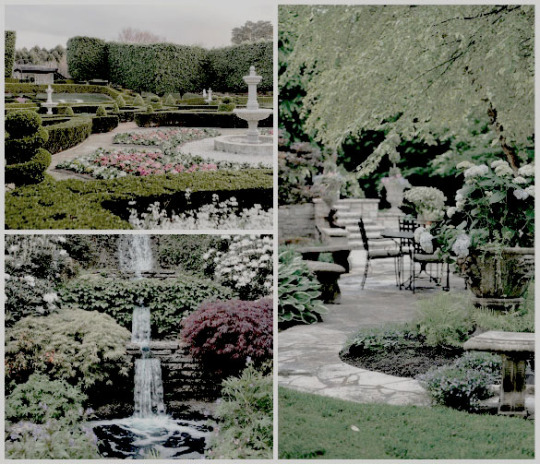
The gardens are in the more immediate property of the Estate. They're located near the West Wing of the building. The gardens are expansive, enclosed with hedges. The main garden with the flowers, fountain and little stream/fish pond can be found by traveling through the hedge maze.
_ fitness _
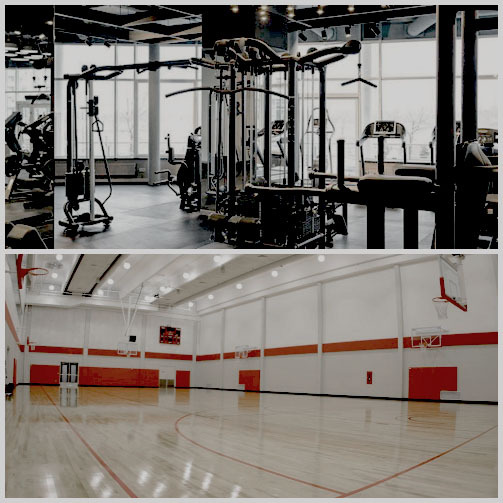
Many of the royals have great pressure on them to keep in tip top shape, and many like the option to. The Estate provides two main outlets for working out. They have a gymnasium complete with an indoors basketball court, gym mats and a volleyball net set up.
_ outdoors - hangouts _

For the outdoorsy royals, there's several spots for hanging out.
Top Left: The Lake. During the warmer seasons, many of the royals take to the lake for swimming, or hanging out. Parties have been known to take place by the lake. During the off seasons, figure skating is something many of the royals take part in.
Top Right: The Cabin. During the initial years of the Estate, during the Pilot Program, there was a great deal of uncertainty on whether the royals they were keeping would try to escape or not. Before developing a better security system, they used the cabin as a guards post. While it's been mostly abandoned, some of the royals use it as a hookup spot, or just to get away.
Bottom Left: The Woods. With the estate being as vast as it is, the property expands over several acres of land. A great deal of the land being wooded area. There have been man made trails flattened out for the royals to walk about or ride the horses from the stables along.
Bottom Right: The Field. A grassy field is also found on the expanse of the property. The keepers of the Estate keep the grass trimmed and maintained. Many of the royals bring their horses up there or picnic.
_ school - places _
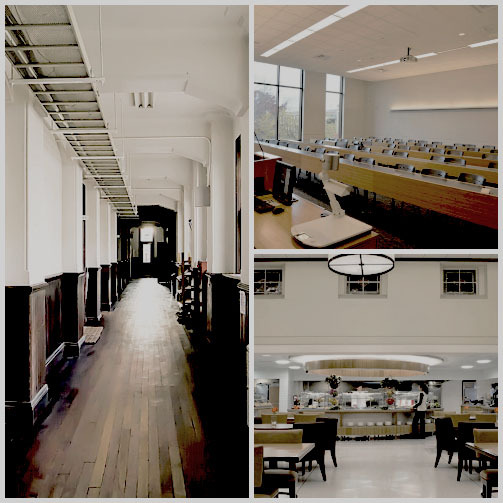
Between the two dormitory buildings, there's the building for classes and community meals. As well as the physical fitness areas, swimming pool and hospital wing.
Left: The Hallways. The hallways are thin and generally not used for a main hangout spot. But they are busy and packed with students most days. The windows all have wide sills so some students sit in them and view the property.
Top Right: The general classroom setting is a modern, small lecture room looking area. These classrooms are the normal for both academic and royal classes. Though gym is held in the gymnasium, outside or the fitness center. And art is held in another classroom.
Bottom Right: The dining hall is a modern area with cushioned seating and a more restaurant looking sort of vibe. The tables often seat four or six. There's a buffet for salads during lunch and supper and breakfast foods in the morning. The main courses are served at the roundabout bar by cafeteria workers.
_ dorms _
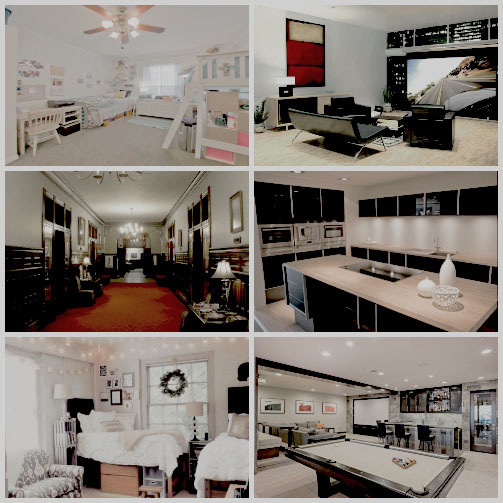
Top Left: Bedrooms. All dorm bedrooms are identical in size. Though set up is varied. Many of the royals design their own room outlays to their particular styles. Though furniture such as a bed, desk and night table are provided, most royals return these for storage and bring in their own. Each bedroom has it's own ensuite bathroom that includes a tub/shower area, a standing shower, a two person sink and toilet area. The rooms host two people.
Middle Left: The hallways. They greatly resemble a hotel in structure and are carpeted and decorated with vintage desks and chair sets. The walls are adorned with pictures of past royals.
Bottom Left: Another outlay for the bedroom space provided. Refer to Top Left.
Top Right: Theater Room. In each dorm, there's a theater room. It's linked to a program that contains several movies and tv shows, as well as music programs. It has a surround sound system. Most dorms host a movie night every now and then.
Middle Right: The dorm kitchens have a very modern look. They have all the means for royals to take care of their cooking needs. While most royals eat meals in the main dining hall, some prefer cooking for themselves or like snacking at night. Most times, guards stop by every now to ensure the royals aren't getting up to no good.
Bottom Right: Entertainment room. Each dorm also holds an entertainment room that are frequented by the royals. They have pool tables, a sitting area with a flat screen tv and the same program as the theater.
_ gameroom _
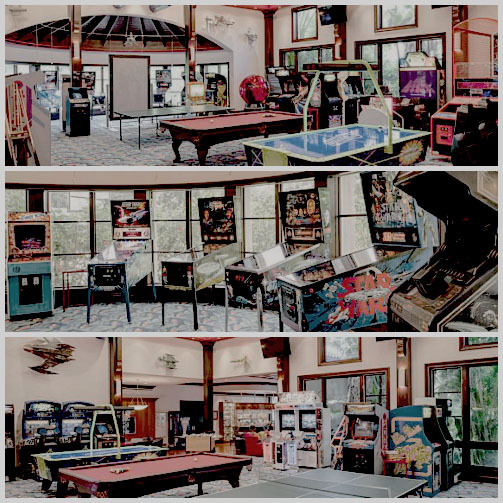
In the main part of the building, there’s a game room for the royals to entertain themselves. This part of the building is new, and was built for the initiate program’s arrival. An endowment from one of the Pilot Program Royals parents was what paid for it being built. The game room is much like an arcade, and has several vintage games, as well as ping pong, pool, air hockey and ski ball.
_ library _

Within the main part of the Estate is the library. It has a more vintage look, with three floors. The three floors is home to fresh on the market computers, books, and desks. The spiral staircase is the way to the second and third floor of the library.
_ hospital - wing _

Because so many royals tend to be private, especially because half the treatments within the place are stomach pumps, overdose treatments, and prenatal care the Estate started off with a hospital wing to treat as many possible things they could. Their equipped for small surgical procedures and often have private transportation to the private hospital in town for any other procedures not provided at the Estate.
_ general - hangouts _
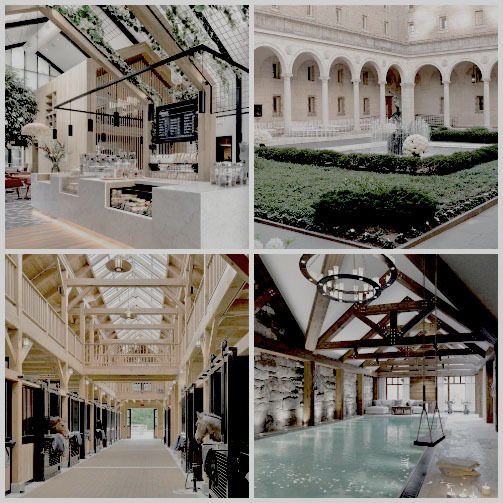
Top Left: Cafe. The cafe is a small coffee shop that most royals take to for hanging out. They serve several hot and cold beverages, as well as baked goods. Many of the royals go there for their morning coffee and snacks. They often hang out there between classes and after meals. The cafe closes at 12AM and reopens at 8AM.
Bottom Left: Stables. One of the things Royal Pains prides itself on is it's equestrian ventures for royals. Since many royals are taught to ride at an early age, the estate provided an opportunity to bring their horses.
Top Right: Courtyard. In the back of Estate is the Courtyard. It's a simple fountain area with a small hedge and a few benches for sitting down. Most royals don't hangout there so the ones who do are often seeking out peace and quiet.
Bottom Right: Swimming Pool. As another outlet for fitness and general recreation, the Estate's provided a swimming area. The swimming area also has a whirlpool tub. Though there's a locking system and there's a pass required, students have been known to break in.
_ town - hangouts _
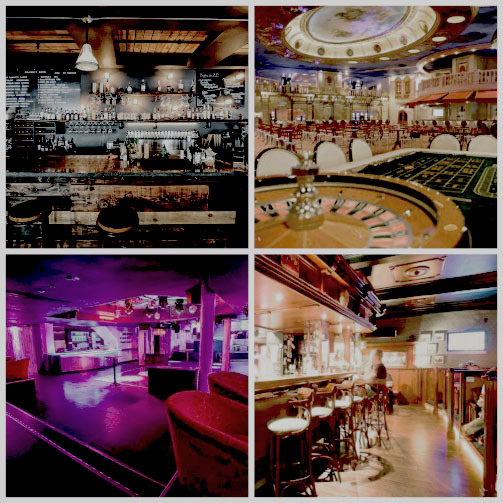
Along with Estate hangouts, there's several spots in town. While it's much harder to obtain passes to actually make it out into town, some royals have been known to sneak off the property and go out. Which is when they're most known to hit these party spots.
Top Left: Salem's Gate. Salem's Gate is a frequently populated bar in town. It's bigger, with several tables and a big bar space for people to sit at. They have waitresses to serve drinks to those sitting and often have some form of live music playing.
Bottom Left: Nightsounds. The Nightsounds club is frequently by the younger crowd. If someone's looking for live DJ's, loud music and a spot to dance, Nightsounds is the place to go. There's a few sitting spots, but most people don't go to hang out.
Top Right: Arden's Casino. Arden's is an underground casino. It's not popularly known, but the royals of the estate with trust funds to gamble away are the biggest customers. The Casino runs all night on the weekends.
Bottom Right: Smoke and Mist Pub & Grill. The Pub and Grill is a small hangout known for their homemade selection of fast food. They occasionally hold a karaoke night. It's not a popular spot for royals, but some go for the food.

Shopping Center: The shopping center is a popular spot for royals to hangout at. When most get their passes to go out, this is their go to spot. It holds several high end and common stores, as well as cafe's, dessert places, little boutiques, jewelry and tea shops. They also have a food court for those who decide they want to stop and have a meal while they're shopping.

Top: Arbello’s. One of the more upscale restaurants in town. While the town isn’t thriving with rich families, enough teenagers saving up for dates and the presence of the royals has caused high enough demand for the place to stay open. It has a large floor setting with a dim, romantic lighting.
Middle: The Beach Restaurant. This particular restaurant is a semi-upscale place sitting on the beach front property. With a lot of natural lighting, a wide open floor plan, a view and a bar, this is a popular spot amongst the townsfolk and royals alike. During the spring and summer seasons it’s not so uncommon that it’s booked out for wedding receptions and other events.
Bottom: R&W Diner and Drive-Thru. A popular spot for townspeople. The diner is known for it’s homemade fast food. Along with friendly service, old timey feel and family vibe. Not many royals frequent the area, but the occasional few do.

Top: The Beach. A popular hangout for the people of the town during the warmer seasons. The beach also has a restaurant known as the Oasis. It opens it doors in the Springs and closes them at the end of September. But the beach is accessible all year round.
Bottom: The Swimming Hole. The swimming hole is a popular spot among the younger crowd and families that grew up in the town. But royals on passes during the summer tend to take the opportunity to go swimming and host parties at the swimming hole.
2 notes
·
View notes
Text
This is a companion post for my Hannibal fic What The Water Gave Me which is, as far as I know, the only fanfic ever to need a companion post about flood hydrology. On Saturday, May 14, 2011, while Hannibal was shopping in the French Market, the Corps of Engineers opened one quarter of the gates on the Morganza Spillway and flooded about 4,600 square miles of south Louisiana. In places the flooding reached 25 feet. This was in addition to the previous opening of the Bonnet Carré spillway Sgt. Germaine Grant mentioned in chapter 2, which flooded a stretch of land between the Mississippi River and Lake Pontchartrain near New Orleans. You might even remember Sgt. Grant telling Jack and Hannibal that they were in a record breaking drought at the time. How, you may be asking. Why? You should be asking. It's insane. The Why is such a big deal it might have actually started the Great Depression, reversed the main political parties of the US, reshaped the racial demographics of America's cities and created a musical genre.

This is the watershed of the Mississippi River. Every bit of water that flows from every bright spot on that map, from rain, drains, toilets, crop irrigation, whatever, eventually makes its way, like the world's grossest funnel, down, more or less, to a single point at Red River Landing, Louisiana, where the Red River meets the rest. Not too south from there, the Atchafalaya river splits away from the Mississippi. Over the last few hundred million years, the Atchafalaya and the Mississippi have wiggled all over the place, as rivers do, and at any given time, which one was the major outlet to the sea has changed. Rivers do a lot of predictable but unpredictable things, but the most predictable thing they do is seek the lowest ground and the easiest path. If there isn't an easy path the river will make one.

In 1927, due to heavy rains all over the watershed, the Mississippi River flooded 27,000 square miles up to 30 feet and displaced well over 600,000 people, mostly in Arkansas, Mississippi and Louisiana. Monetary damages were equivalent to about one third of the entire Federal Budget at the time, or, in modern dollars, over a trillion dollars. Crop failures were huge, driving up food prices nationwide. Let me repeat that. 630,000 internally displaced refugees within the US, within the last century. Did you learn about that in school? I took 2 Louisiana History at two different schools, then took three American History classes at a college in the flood zone, and I learned about this because I googled a Randy Newman song in 2005.

200,000 of the displaced people were poor black people from mostly rural areas, most of them one generation removed from slavery. Most of these folks had little to nothing to use to relocate or to live on, so they were herded into refugee camps where they were stuck with nowhere to go and minimal supplies until the water started to recede months later. Racial tensions were sky high, and the racial disparity in aid, rescue and support was extremely clear. As soon as the water was low enough, tens of thousands of displaced black families joined what we now call The Great Migration - they didn't have a home to go back to, so they went to the big cities, both in the south and, for the first time, up north. Anybody you can think of from the classic Chicago blues scene? Probably ended up there after being displaced by this one event. Mahalia Jackson, who I spotlit last chapter, moved to Chicago at this time as a victim of The Great Betrayal (man, the 1920s were Great, huh?)
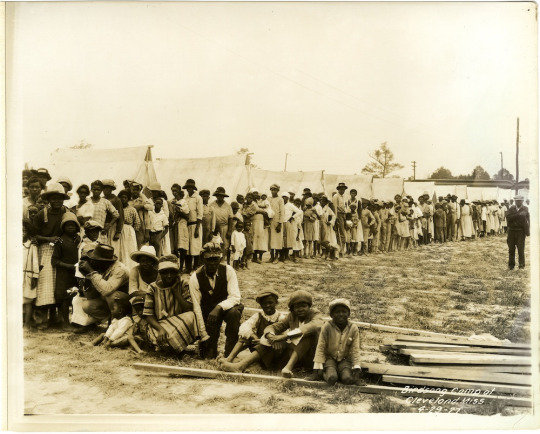
President Coolidge put Herbert Hoover in charge of managing the camps, where he made a whole lot of promises and ended up president. When he didn’t fulfill any of his promises to the black refugees, the entire black voting block swung, more or less permanently, to the Democrats. Huey P. Long rose to power in Louisiana on a wave of socialist populism and probably would have been president a decade later if he hadn’t been assassinated in the middle of the capitol building. If you don’t know about the Kingfish, look him up, because holy fuck our country was almost really, really different. As for the Great Betrayal I mentioned?

Wealthy (white) businessmen in New Orleans arranged to dynamite a levee in Caernarvon, Louisiana, flooding areas of St. Bernard and Plaquemines Parish where tens of thousands of (poorer) people lived and worked. Reconstructions have shown this was pointless and New Orleans would have been fine, because so many levees had already breached in other locations. Basically no one was ever consulted or compensated for loss of property and livelihood. So it's no wonder that, during and after Hurricane Katrina, there was widespread belief that the flood protections had actually been deliberately sabotaged to flood the lower 9th ward and save downtown. People remember when you fuck them over and they never trust you again. Every school I've ever attended would have been underwater during the 1927 flood, but I never learned anything about this, or about how we've stopped that from ever happening again. Sit tight, it's nuts. Prior to 1927 levees were local projects and they were largely homemade by non-engineers. Surely one big pile of dirt is the same as another, right? But levee construction is an art and a science. Alluvial dirt wants to settle; the ground is wet and it wants to move. After the shitshow of the Great Floods, the federal government created the world's largest flood control project. This is what federal governments are for. The U.S. Army Corps of Engineers, those unsung superheroes, planned and built a carefully planned and, one hopes, carefully maintained series of interconnected levees, dams, floodgates, spillways, canals and wetlands stretching across that whole area in the top image, but mostly along the Missouri, Ohio, Red, and Mississippi and Atchafalaya Rivers. It's known as the Mississippi River and Tributaries Project (MR&T) The Lower Mississippi and the Atchafalaya Basin in particular got a complete makeover.
We'll start at the very bottom, because it's simplest. The Bonnet Carré spillway was built 12 miles west of New Orleans to divert the Mississippi around the city in case of very high water. This spillway controls what was a natural flood route for as long as we've been keeping records and is opened on a fairly regular basis - every decade or so. This was one of the first parts of the MR&T completed, just four years after the flood. It's a mile and a half long and runs alongside of the river. When it opens, a channel about six miles long is flooded, dumping the river directly into Lake Pontchartrain and the surrounding marshlands to save the more populated areas. Lake Pontchartrain is huge (home of the longest bridge in the world!) and it has a wide opening to the Gulf of Mexico, so it can basically absorb as much water as we could possibly throw at it. Upriver a bit, things are a little more complicated. I'm not going to go super in-depth. There are numerous control structures connecting the Atchafalaya and Mississippi. The biggest and the one most relevant to our story is the Morganza Spillway, located in Pointe Coupee Parish, upriver from Baton Rouge. If the water gets too high, it will overtop and undermine levees, and the force of moving water becomes so great that it would just shred the other existing control structures, even if they are wide open to let the most possible water through. There needs to be another emergency safety valve to take pressure off the system. The Morganza Spillway is about a mile long, and when it's wide open it lets 600,000 cubic feet of water through per second. That's about half the flow of the entire Mississsippi river at moderate flood stage, passing through one man-made structure, under the control of a handful of human beings.

So in the worst possible flooding scenarios, as happened in 1927, in 1973, and in 2011, the ACoE opens a little gap in the weir. They've never opened it all the way - max capacity has never been tested. This is a projection map from 2011 for what the flooding would look like with the system running at one quarter of total capacity (which is the scenario that ended up happening). Because yeah, people live in those areas! The area's also farmed for timber and drilled for oil. There isn't much commercial fishing - that mostly happens in the Gulf - but there's fish farming, including crawfish ponds. Mostly it's protected or semi-protected wetlands occasionally dotted with camps. I'm not sure if that word is in common usage with the same meaning elsewhere, so just in case, a camp is a (usually but not always cheap or rustic) house or structure not intended for full-time residence, where one can stay for access to water or hunting. You actually have to get a lot of surveying and permissions to build anything anywhere on any body of water in south Louisiana, because the balance of flood control and wetland preservation is so important and precarious, so most of the places in this area will have been grandfathered in rather than freshly built. The Morganza Spillway has been opened twice, once in the 70s and once during this fic. There is a huge, eight parish long and wide river moving over land that's been dry or swampy and only sparsely inhabited for 45 years. Think of all the things it might pick up on the way to sea?
57 notes
·
View notes
Text
What to Look For When Buying Bird Netting

If you’re thinking to buy a Bird netting, there are some tip and thing to consider before purchasing it. There are various bird netting available in the market now its depend on your needs. Look for a netting system that provides effective bird barriers for fish farm ponds. This type of netting is effective in keeping predators, such as ducks and herons from your high valued product. This is a must when running a fish farm as birds will swoop down and eat up your profits.
Bird netting is effective in a variety of industrial applications including bird barrier netting for industrial settling ponds. Settling ponds are found at waste facilities so if your company is in waste management or the oil refinery business, remember to choose an industrial application that fits your needs.
When applied to the home, it saves on siding and roofs from needing repair or replacement. It eliminates destructive and caustic bird droppings. The bird’s feces corrode metal, destroy finishes and change the color of paint. Garden bird netting will cut costs of repairs and prevent the drop in your property aesthetics and value. For balcony nets visit us.
Scaring birds is another idea. There are many homemade and commercial reflective and noise devices that work… for a time. Try using pie plates, old CDs (remember those?), aluminum foil and even turned on radios around your plants.
I like using the holographic ribbon strung on posts in the planting. It’s important the devices move to reflect light and make noise so place them where there’s good wind. Try a number of different devices and techniques to confuse the birds. Scare eye balloons works well as long as you move them every few days. Stationary plastic owls, however, look cute, but I remember seeing a crow perched on one waiting to descend on a garden. For balcony safety nets Bangalore Visit us.
Bird droppings can destroy almost any building material, including wood, stone, marble, steel, and iron. The accumulated droppings can also damage roofs, clog gutters, discolor paint, corrode I-beams, ruin cloth awnings, and short out electrical equipment.
An important consideration in the building process should involve how to prevent birds from roosting on the structure. Installing bird deterrents at the outset of a project (rather than retrofitting) saves time and money, and eliminates the dangers of bird-borne diseases, material degradation, and the unsightly mess of bird droppings. The time and effort required to remove bird waste, along with the dangers associated with handling it, makes front-end installation preferable. For anti bird net price Visit us.
0 notes
Text
The Hermit of Russian Lake
by. J. Sullivan
Big Moose Lake had been an out-of-the-way destination for vacationers and hunters since the late 19th century. It managed to retain much of its remote nature during the 20th century, unlike most of the Fulton Chain, a series of vast lakes not far south of Big Moose. While the other sizeable lakes in the central Adirondacks had become tourist hubs—lined with grand hotels, serviced by steamboats and railroads—Big Moose only begrudgingly built new settlements; and the hotels that did spring up were never all that successful.
Keith Lane had visited the area with friends over the years and wanted to share some of the charming solace of the lake with his wife, Becky, and their baby girl. He hoped to build a foundation for positive mutual memory there, and have a spot to return to each summer that they could make their own. He and Becky were having a difficult marriage, wanting different things in life, with disparate plans and goals. The vacation was meant to be a first step toward mending their relationship.
However, things never seemed to go as planned for Keith. Becky hated the cramped confines of the bungalow that her husband had rented. She complained from the minute they arrived, about the furniture, the lack of things to do, the difficulty of caring for their one-year-old daughter in an unfamiliar place. She really let Keith know that he was putting her out on this little vacation of his.
Not a day and a half had passed before Keith needed to get out of the cottage and away from his wife’s niggling. Becky and the baby were sleeping, so he decided to take the canoe from the backyard and put it out onto the water. He knew from an earlier trip that in the eastern bay of the lake there was a dock, and from there a short hiking path to a campsite and pond. He was determined to ex-perience a little of his own type of vacation, whether Becky gave him a hard time about it or not.
The forty-minute-long paddle was leisurely, with a gentle wind at his back. Not many powered boats were out on the water that day, likely because it was overcast and threatening rain. He waved to a carpenter piloting a flat-top motor boat full of old dock lumber.
Keith arrived at the small dock and tied up his canoe. He found the marked, flat forest trail with ease and followed it toward Russian Lake. The path appeared well-travelled, and along the way he passed a man and a boy carrying a canoe, presumably back from the pond. They paused to talk.
“Hey. Were you guys camping?” asked Keith.
“Yep. We stayed overnight at the lean-to. It’s really a nice, little lake up there,” said the father. “It looks like it might rain, so we’re trying to get back.”
Keith left the pair behind and continued on the path for another half-mile until he reached the lean-to, which sat on a bluff overlooking the pond. He saw the obvious signs of the campsite in front: a fire pit, trampled grass, and indentations where gear had been parked for the night.
The pond itself held a small island, densely covered with trees, grass, and underbrush, as was most of the surrounding area. It was the end of the trail, and he thought it odd that there weren’t more trails going off into the vast Pigeon Lake Wilderness Area which lay to the north, south, and east.
He wandered down to the small lake, peering into the brackish water for any sign of life. A beaver caught his attention as it swam from shore to the small island. He spotted the creature’s bulky timber pile near a small outlet stream and searched out a spot where he could get a better look at the developing dam.
When Keith had walked far enough along the shore, he spied a gently tread game path that he could follow to the outlet. He waded through tall grass, flicking burrs and thorns, and swiped away various clinging bugs from his pants. Loons called out from a thick patch of reeds nearby; their eerie, almost wolf-like territorial posturing made him jump. Finally, he reached the outlet stream and looked over the beginnings of the dam.
The sun peeked out for a few minutes, and Keith saw something metallic shimmer downstream. He walked along the rocky brook toward the mysterious glistening beacon. Eventually, he could begin to make out some sort of structure among the trees. A little clearing had been made, on which sat a shack.
Keith had heard stories of the guides, mountain men, and hermits who had once occupied solitary settlements in the deep woods—men who had been present for nearly every exploration and discovery—the lore-makers themselves. He was a student of Adirondack history, yet was stunned at the existence of a hermitage in the 21st century—reasoning that the state of New York wouldn’t stand for such a thing on its hallowed public land.
Smoke drifted from the makeshift chimney of the cobbled-together structure. The aluminum wall panels and asphalt shingle roof were set at odd angles—and the whole thing seemed about to collapse. Keith was startled from his structural study by the emergence of an old hermit, obviously the proprietor of this squatter’s refuge.
“Are you lost?” asked the old man.
“No,” replied Keith.
“Then get lost,” said the old man, abruptly, and returned to his abode.
Keith paused, unsure if he shouldn’t just turn around and hurry himself back to his canoe. The old man returned with a tobacco pipe in his mouth, already puffing at it in caricature of the classic Mountain Man.
“Sir, my name’s Keith. I was checking out the beaver dam and saw the sun shine off the aluminum down here. I was just curious, you know?”
The old fellow sauntered over to him. They both stood about the same height, a little over six feet tall. “As you can probably figure out, I’m here on this land illegally, and any mention of my being here, to the wrong sort of people, will get me arrested and tossed out on my head.”
“I won’t say anything. I’m just at the lake for a week on vacation.” Keith looked at the weathered shack and the surrounding area with curiosity. “How long have you been out here?”
“Decades… But who’s counting?” The old man broke a yellow, wry smile, and continued to puff away at his pipe. “I suppose you’d like to see inside?”
Keith nodded and followed the old man into the shack. The first thing he noted were the modern provisions. There were canned food tins, a tidy collection of recyclables, and a newer portable propane stove. It all struck him as neatly utilitarian. The only non-essential items seemed to be a stack of hardcover books and a few magazines that sat on one small, homemade table.
“Do you want some coffee?” asked the old man, as he set some water to boil on his stove.
“Sure.” Keith was directed to sit in one of the rough-hewn chairs.
“So, what do you think?”
“Sir, I’d have to say that I’m surprised at how well-organized everything seems.”
The old man nodded. “Thanks. I’ve had time to get things right. Plenty of it.”
“Do you hunt and fish for food?”
The old man looked at Keith queerly. “No. I buy my food in Eagle Bay at the market, the same as everyone else. I do make a little money trapping—legally, of course.”
Keith was taken aback at how normal the hermit seemed. He figured there had to be something horribly awry in the psyche of someone brave enough to endure an Adirondack winter in such a hovel.
“Does it get boring out here?”
“No. Just simple.”
“God, I wish my life would get simpler. I have a baby girl, and my wife is sure she wants us to get separated.”
“Sorry to hear that, son.”
“It’s just so goddamn infuriating that she can upend my life because she’s bored, or sick of it all, or whatever.” Keith looked at the old man, who had been listening intently. He was embarrassed by what he had just revealed to the stranger.
The old man added some instant coffee to the now-boiling pot on the stove, and then poured two mugs, setting one in front of his guest. “You’ve a right to be angry.”
“I’m sure life out here can be miserable and difficult, but it seems like it can be a paradise, too.”
The old man didn’t respond. He gave Keith a bagel and sat down in the other rickety chair across the small room. They sat in silence for a few minutes. Rain began pattering on the roof and aluminum walls.
“I should probably get back before it starts pouring,” said Keith, standing.
“Do you have a motor?”
“No. Canoe.”
“It’s going to be a rough paddle back. The wind pushes east,” said the old man, feeling briefly paternalistic toward Keith.
“I’ll be fine.”
“Don’t exhaust yourself. Tie up to docks along the way and rest.”
“Okay, thanks.” Keith took a few steps to the door then paused. “You’ve got a real great spot out here. I won’t tell anyone.”
The old man nodded his thanks, and Keith left the cottage. He jogged back down the brook to the pond, then up to the trail that began at the lean-to. It was raining lightly by the time he got into his canoe on Big Moose. The water was already pushing roughly against the far eastern bank.
As soon as Keith nudged out onto the water he knew the wind was going to be a real problem. He tossed his backpack into the front of the canoe to try and keep the bow even with the stern. But his backpack wasn’t heavy enough to keep the front end of the boat down, and the wind was pushing it each way, making paddling in a straight line impossible. He struggled against the piling water and strong gusts to drag the canoe, little by little, away from the dock.
The first twenty minutes were fine. He made decent headway and was practically within sight of a smaller bay to the south, which had a public boat launch. But the storm grew increasingly intense and he knew that he wasn’t going to make it back to his cottage on the water. It wasn’t a long walk from the launch to where he was staying, and he could return with his Jeep and grab the canoe from the parking area.
Twenty more minutes had passed by the time Keith realized he had gone no more than fifty yards. He was paddling furiously and his shoulders, back, and arms were fatigued. He knew he could always stop at one of the docks or even pull his canoe onto the shore and deal with the possibility of an unfriendly dock or cabin owner. A group of older ladies passed him with their speedboat and waved as he tried not to panic from his predicament.
The combination of a sudden blast of wind followed by a small wake from the passing boat knocked the paddle from Keith’s hand. He lunged for it and had it nearly within his grasp when another strong gust sent him plunging into the water. The canoe tipped behind him, knocking him in the head. He struggled against his open life jacket in trying to find the surface, cursing himself for loosening it when he had begun to sweat from exertion.
The carpenter’s flat-top boat, now devoid of cargo, pulled up alongside Keith as he was treading water. The man pulled him and his canoe on board. Keith, completely exhausted, could barely manage a thank-you to his rescuer. The rain was pouring as the boat cut through the choppy water and away from East Bay.
“Are you staying on the lake?”
Keith could only nod and point; he was out of breath, cold, and sodden. But he was able to direct the carpenter to the dock off the property where he was staying with little issue.
“Christ. Thank you so much, man,” said Keith as the pair unloaded his canoe right onto the dock.
“No problem. You’re not the first to get stuck out there. I don’t know why they bother maintaining that dock and that trail to nowhere,” said the carpenter.
Keith shrugged and tried not to grin as he thought of the old man. He thanked the carpenter again then returned to the cottage, unsure of how much of his tale he’d share with Becky.
* * *
The hermit of Russian Lake wasn’t used to having visitors. Linear time for him was inconsequential, and how much of it passed between events was nebulous, at best. There were three seasons in his world and they merely cycled. Winter was an endurance event each and every year, followed by mud season (which coincided with an incessant black fly nuisance), and finally, summer.
Summer in the Adirondacks was the reason one would endure the other two seasons on the fringes of the wild. The hermit didn’t consider himself ‘of the wild,’ as he benefited from modern convenience, the same as the campers who came out to his little lake every so often. He shopped once a month at the Big M grocery store in Eagle Bay; the hike wasn’t bad at all once he found the maintained trails south of Big Moose.
He had enough money saved that he could continue his meager existence indefinitely. The Community Bank in Long Lake saw him once per year. He cashed his fur and hide checks, and withdrew a varying amount, usually based on the projected price of propane for the winter.
Though the hermit mostly kept to himself, a small legend had grown around his periodic appearances in the towns from Inlet to Long Lake. He had acquaintances that he spent time with during the hunting and trapping seasons. Most didn’t know that he lived in the woods, and he shared very little of his past with them—a past which he had mostly suppressed, or nearly forgotten, by the time he had spent half of his life as a solitary recluse.
A young man appeared at his door one summer, as if he had been there before. He even seemed to knock as if he were visiting an old friend. It irritated the old man—the wandering curiosity of the upper-middle-class who descended upon the big lake from their luxurious ‘cabins,’ with party boats, speed boats, and now biplanes. They would traipse into his world from time to time, but they usually turned on their heels at the first sight of his camp, and well before making contact.
“Yes?” said the hermit, answering the knock, but not the door. He figured a little unpleasantness would be enough to send the visitor on his way.
“My name’s Keith. I met you out here a few years back.”
The old man shuffled to the door, exhausted from a morning spent chopping wood. He opened it but didn’t recognize the interloper. “Yeah? I don’t remember you.”
The young man paused, considering if he should just leave. “I was staying on the lake with my wife and baby girl. I canoed over, followed the stream, and wandered into the clearing. We had coffee?”
The hermit looked at him quizzically, half-remembering some detail. “I don’t get many visitors out here. And if I recall correctly, the last one may have drowned on his way back over Big Moose during the microburst. That storm did a helluva number on my cottage. It nearly tore my roof off.” He pointed to some of the repairs he had done over the door.
“I’m looking for some advice. I think I might want to try and live a solitary life in the woods.”
The old man chuckled, openly sneering. “My advice?! I’m the last person who should be doling out advice on how one should live.”
“I’m not on a spiritual quest or something—I’m running from the police.” Keith felt relieved to reveal his troubles to someone. “I’m just looking for a few tips, maybe an idea where I should go?”
The hermit’s brow furrowed. “Are you a thief?”
Keith shook his head. “No. I just haven’t been making the best decisions lately.”
“No, you haven’t. Someone certainly saw you come over here, and eventually I’ll be found out because of it, and my home will be demolished. Not to mention, I’ll be arrested like a common criminal.” The old man looked the fugitive over. “Come in, I suppose.”
He let Keith in and closed the door.
“Jesus. I’m sorry. She was gonna leave me. I actually saw red. I didn’t think it was a real thing, but I actually saw red and the knife was right there on the cutting board…” said Keith, panicking.
“Stop it! I don’t care what you’ve done or who you are. We’re screwed now. Both of us.”
Keith broke down, sobbing. “I loved her more than anything, and she just wrecked everything for us, for my daughter…”
The old man sat Keith in the rickety chair at his small wooden table. “Give me a minute. Let me think about this. We can figure something out.”
There was a firm knock at the cottage door, and the hermit was pulled from his silent meditation. He nervously turned and approached the door, hesitant to pull the handle.
“Hello?” said a man’s voice.
“Are you lost?”
“No.”
The old man opened the door on a solitary hiker, a young man of about thirty.
“Sir, I’m sorry to bother you again. I was trying to paddle back out of the bay, but the wind was just too goddamn strong; so I turned back.”
The hermit noticed that it was raining, the pitter-patter growing louder against his aluminum siding. “Again, huh? I’m really busy right now—just go back and wait in the lean-to for the storm to pass.” He turned back to check on Keith, but he was gone. He looked around the small cottage for the man. “Keith?! Where the hell did you go?!”
The man at the door answered. “Sir, I’m right here… My name’s Keith Lane, remember? We met and chatted a couple of hours ago. I’m vacationing with my wife and baby girl just down the lake.”
1 note
·
View note
Text
ways To Clean Your Koi Fish Pond
Louse are easily to recognize on the bodies of the fish because they are plainly visible. However, it is necessary to carry a careful examination of the body of the fish, specifically in the covert areas behind the fins. Lice might appear as dark spots when they are stagnating. The fish will be fairly flustered and will move their body a lot if there are too many lice. A single Blue Heron can feed off about 100 six-inch koi as its dish for the day. It is hence crucial that your pond should have at least eight feet of water in order to keep these predators at bay. You can also set up a bird web over your pond as a way of warding-off predators. There are nevertheless other things which can improve the fantastic appearances of a pond. Koi find comfort in shade like those provided by water lilies. So, owners can cover their ponds with up to 70 percent of its surface by lilies. Lilies lower the degree of algae in the water, aside from the fact that they offer the koi with cover and shade. Arm is a favorite and widely make use of canvas for tattoo designs. It is because el born area is generally exposed or noticeable and supply an enormous work space that will begin from your arm right down to your wrist by which we call sleeves tattoo. Designs on this areas is different from pin up women to tribal together with Japanese and chinese design such as the popular koi fish. Deltoid tattoo designs usually are not as painful as those on the wrist. forearm and the thinner inside skin with the arm. These are simply some of the important things that you should understand before you start this pastime. Now that you have everything up and running, now you have a different set of concerns. Aside from the technical element, the design is another significant element. How are you going to create a cleaning system if you are not knowledgeable about its architectural structure? Sure, you may have been taking care of Koi Fish for some time, but can you honestly state that you totally understand all the standard elements of a koi pond. I will presume that you have actually contracted an expert to construct your fish pond, and more than likely the purification system is part of the construction. Are you confident to make your own design simply by observing how your pond operates? Nevertheless many individuals are not pleased to stick to exactly what everyone else has already done and the majority of people that get tattoos desire them to be unique and various. For that reason tattoo artists are always on the watch out for brand-new designs, new concepts and brand-new ways to take their art to the next level. This constant pushing of the envelope establishes many hot new trends in tattoo design. One of the most impractical reasons for making a homemade pond pumps and filters is the technical element. discover more here of system is very vital in the proper maintenance of any fish pond; therefore, it is essential that the person who will make this is knowledgeable on the technical side. There will absolutely be an opportunity that a filter made by somebody not extremely techy will have some glitches. And this is something that your koi fish can not afford.
0 notes
Text

Homemade Fish Habitat For Ponds
If you have some time, passion and a little bit of creativity, we offer our pre-cut vinyl loose, pieces that you can use to make your own fishiding artificial fish habitat structures and pallet fish structures. PVC fish habitat that you can make using our PVC fish structure designs. If you are looking for DIY fish habitat or DIY pond habitat, you are in the best possible spot. Gather help of all ages and set up a day of helping out the homeless with PVC pipe dock fish feeder. Visit: https://www.fishiding.com/diy-artificial-fish-habitat-structure-materials/
0 notes